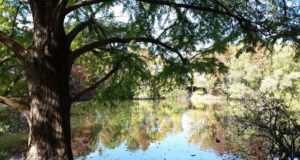When my now-ex and I were first married, we lived in the northwestern suburbs of Chicago. We used to visit the Chicago Botanic Garden (link to follow after I come back from my August 2016 trip to Chicago) on a fairly regular basis. So when we came down here to Texas and found ourselves with nothing to do one day, we decided to check out the botanic garden here in San Antonio. And, while it was not as elaborate as the one in Chicago (and was much, much smaller!), we liked what we saw. I have maintained a membership to the garden on and off for the last 23 years. I love having a membership because there’s no pressure to spend all day at the garden. If you want to drive on down there and visit the conservatories then leave, you can.
The site that now holds the Botanical Garden was originally the city reservoir. It’s kind of hard to tell unless you’re at the very top of it, but the land is on top of a hill and the city was able to use gravity to deliver the water to homes in the area. This period lasted for about seven years, from 1883 through 1890. According to the Botanical Garden website, local residents began to worry about the reservoir becoming contaminated and so it was abandoned. The land of the reservoir and the surrounding area became the San Antonio Botanical Garden 90 years later, in 1980.
Today, the garden has lots of smaller gardens within it, including a Japanese garden given to the city by our sister city of Kumamoto in Japan; a series of conservatories; an area of small houses that demonstrate different ways to landscape in a water-conscious way without just yanking out your lawn and putting in rocks (a pretty common approach here, I’m afraid); an assortment of formal gardens; and my personal favorite, the “Texas Native Trail.”
The Texas Native Trail takes up quite a bit of space, so I’m going to focus more on it. There are three sections to the Texas Native Trail. The northernmost part is set up to display the plants of South Texas. The South Texas area has an adobe house from the 1880s. Just south of the South Texas area is an area set up to resemble the Pineywoods of eastern Texas. This section has taller trees than you find in most of San Antonio surrounding a man-made pool. The pool is home to an assortment of animals, including ducks and turtles. The far end of the pond has a reconstructed log cabin first built in Fayette County in the 1850s. The southernmost section of the trail is set up to resemble the Hill Country with prairie plants and a waterfall. The Hill Country section has two historic structures, the Schumacher House, which was built in 1849, and the Auld House, which was built in the 1880s.

The garden has a restaurant, housed in the carriage house of Daniel J. Sullivan, an Irish immigrant who set up a bank that helped fund cattle drives. The house, which stood on the land at the corner of 4th Street and Broadway, was razed in 1971. The carriage house stood there for another 17 years. The owner of the land, the Hearst Corporation (who owned the San Antonio Light newspaper) offered the carriage house to the Botanical Garden if they could move it in three months, a task that they (with the aid of the San Antonio Conservation Society) completed successfully. The carriage house is currently the entrance to the Botanical Gardens and I believe that there are offices on the second story.
I say that the carriage house is currently the entrance because the gardens are undergoing an expansion. Much that is currently there will remain, but there is an empty plot of land between Funston and Pinckney streets. The garden owns that land (which has been used for overflow parking in the past) and they are adding new features to it, including a new parking lot and entrance to the gardens. The projected opening for the new section is in the spring of 2017.
The garden has a number of events throughout the year. There are art exhibits and educational programs. They have nighttime events and plants sales, as well. One of my favorite events (and one that I plug to everyone I can) is the Dog Days. For three or four weekends a year, you can bring your dog to the garden for a fee of $5 per dog. That $5 goes to animal-related charities. I try to take my dog (who is a little old lady now) at least once a year because she enjoys getting out and meeting, not the other dogs, but the people at the gardens. And the charities that the garden supports are worth it.
Unfortunately, I don’t think that the garden is as wheelchair accessible as it could be. Some of the paths are steeper than ideal and/or loosely packed sand/gravel/wood chips and, of course, some of the historical buildings are not accessible.
